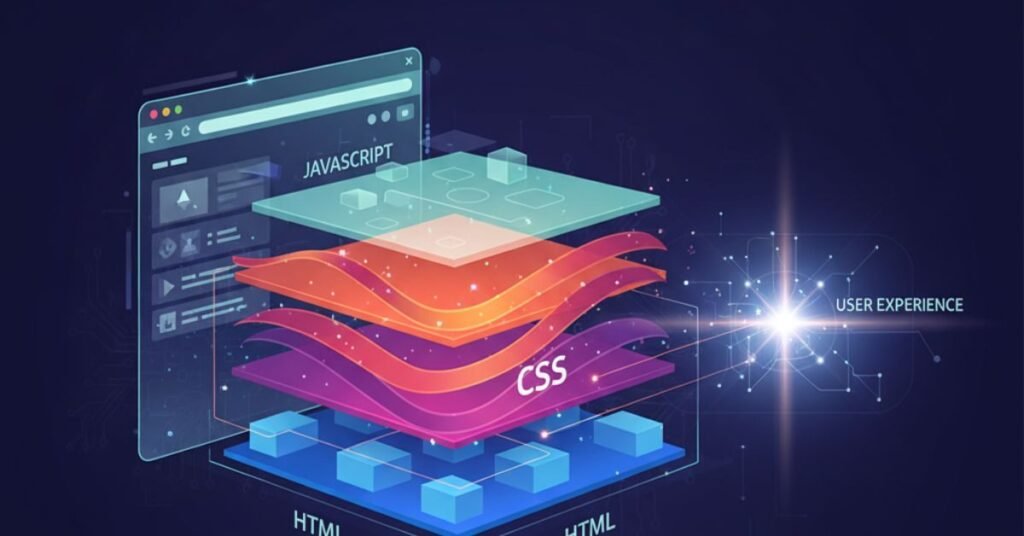Why CSS Matters for Websites begins with you. You go to a page. What grabs you? The arrangement, hues, lettering, spacing—it is all styling. Without CSS it would be bare text. It would be dull, difficult to read, and difficult to work with. CSS (Cascading Style Sheets) makes content attractive. CSS governs design. It makes sites responsive, speedy, accessible. It makes pages uniform. In this article you will become deeply acquainted with valuable reasons why CSS matters for websites and what it means for performance, usability, accessibility, and up-to-date web development.
The Role of CSS in the Web Stack

CSS works together with HTML and JavaScript. HTML gives structure. JavaScript adds behavior. CSS shapes how things look. CSS handles layout, typography, colors, spacing, animations. Knowing these roles helps you separate content and design. When design is handled by CSS, HTML stays clean. That makes the site easier to maintain. When design changes, you touch CSS, not every HTML file. That saves time and reduces mistakes.
CSS also enables you to build design systems. A design system is a set of reusable styles, components, rules. For example, you might define a style for buttons (color, padding, hover effect) once. Then you reuse it everywhere using CSS classes. If you want to change all buttons later, you change CSS in one place. That makes consistency easy. It also helps teams work better because designers and developers share same style rules.
You will like this: Difference Between HTML and CSS
Visual Design & Branding Consistency

Design builds trust. When your website uses consistent colors, fonts, layouts, it feels professional. CSS lets you define a brand identity: logos, color palette, heading fonts, body fonts, spacing, imagery style. Once defined, CSS ensures the same brand look across pages. Users see familiar elements: navigation bar looks the same, footer has the same style, headings are styled similarly. That helps brand recall and trust.
Consistency via CSS also avoids jarring user experiences. If each page uses different font sizes or colors without a system, users get confused. They might feel the site is amateurish. With CSS you can reuse components, use variables (CSS custom properties), or use design tokens. That not only helps visual consistency but also speeds up development. Designers design, then developers style and reuse those styles. Everyone knows what to expect.
Responsive & Adaptive Layouts

People use many devices: phones, tablets, laptops, even big screens. CSS lets your site adapt. You can use media queries, flexbox, CSS grid to build layouts that change depending on screen size. That way content rearranges itself. Menus change, images shrink, columns stack. Without CSS responsiveness, users on small screens get awkward layouts: text too small, menus off screen, scrolling sideways. That frustrates them.
A mobile-first approach helps. You design for the smallest screen first. Then use CSS to add rules for larger screens. It forces you to prioritize content, reduce clutter. It usually improves performance. Also you avoid writing CSS for hidden elements, or duplicate styles. Responsive design via CSS ensures good user experience across devices. It increases time on site, lowers bounce rates. Search engines prefer mobile-friendly pages.
Screen Size Breakpoints with CSS
| Device Type | Screen Width (min) | Recommended CSS Approach |
| Mobile Phones | 320px – 480px | Single column, readable text |
| Tablets | 481px – 768px | Two columns, flexible images |
| Laptops | 769px – 1024px | Multi-column, adaptive nav |
| Desktops | 1025px and up | Full layout, max-width set |
Performance Optimization & Speed

Speed matters. Users abandon slow sites. Google uses performance metrics as ranking signals. CSS affects speed in many ways. Large, redundant stylesheets slow page load. CSS render-blocking can delay first paint (when user sees something). Critical CSS (styles needed for above-the-fold content) can be inlined, rest loaded later. Minification removes whitespace, comments. Merging rules reduces filesize. Tools that detect redundant CSS rules can remove styles nobody uses. These techniques make CSS leaner and faster.
Case study: Some sites noticed Cumulative Layout Shift (CLS) issues from carousels or elements whose CSS layout changes after load. They rewrote CSS flex and grid rules, set fixed base widths, delayed visibility of certain elements until CSS loaded. That improved CLS and Time to Interactive. Performance improved both speed and perceived usability. Users felt the site smoother and stayed longer. Search engine rankings improved.
CSS Optimization Techniques and Impact
| Technique | Purpose | Impact on Speed |
| Minify CSS | Remove whitespace/comments | Smaller file size |
| Inline Critical CSS | Prioritize important styles | Faster first paint |
| Async CSS Loading | Defer non-critical styles | Reduced blocking time |
| Remove Unused CSS | Clean up unused rules | Leaner stylesheet |
| Use Preprocessors | Organize and reuse better | Easier maintenance |
Accessibility & Inclusive Design

CSS isn’t just about making things look good. It can help people with disabilities. High contrast between text and background helps people with low vision. Using relative units like rem/em allows users to scale text. CSS focus indicators help keyboard-only users know where they are. Media queries like prefers-reduced-motion allow people sensitive to motion to reduce animations. CSS lets you visually hide content but keep it for screen readers. CSS supports semantic HTML enhancements. All this helps comply with WCAG (Web Content Accessibility Guidelines).
If CSS is misused, it can hurt accessibility. For example hiding form labels with display:none removes them from screen readers. Using text images rather than real text kills readability and ability to scale. Poor color contrast can make text unreadable. So you must test with tools (Lighthouse, Axe) and make sure CSS supports users’ needs, not just looks.
CSS Features That Enhance Accessibility
| Feature | Accessibility Benefit |
| High Contrast Text | Improves readability for low vision users |
| Focus Indicators | Helps keyboard navigation |
| Relative Font Sizes | Allows zooming without breaking layout |
| Skip Links (visually hidden) | Lets screen reader users jump to main content |
| Reduced Motion Queries | Respects motion sensitivity preferences |
Scalability & Maintainability

Websites grow. Features change. Team size may expand. CSS architecture matters. Methods like BEM (Block Element Modifier), SMACSS, OOCSS help break CSS into modular parts. Preprocessors or CSS variables help avoid repetitive code and duplications. Maintaining a large stylesheet without structure gets messy. You lose track of what styles apply where. You may override styles too many times. That causes specificity wars.
Clean, organized CSS lets teams work together. Designers and developers can follow style guidelines. You can reuse utility classes, component styles. When you update a style (for example button border radius or theme color), you do it once. That change propagates. You avoid inconsistent patches. That reduces bugs and visual drift. The site stays consistent and easier to update.
Read more: How CSS Works in Web Development
Interactive User Experience Through CSS

CSS can make websites feel alive. Hover effects, transitions, animations give feedback. For example, when you hover on a button it changes color or lifts slightly. When a modal opens, a fade effect makes it smoother. These micro‑interactions matter. They signal to users that something is happening. They improve perceived performance. Even when actual speed is the same, a site with smooth transitions feels faster and more polished.
CSS animations can also be used for loading states. Instead of blank screen, show spinner or skeleton screen styled with CSS. Let users know system is working. But don’t overdo it. Too many animations can annoy or distract. Always consider performance and accessibility when using animation. Use media queries like prefers-reduced-motion so that users who prefer less motion have a good experience.
Developer Productivity & Workflow

Good CSS practices speed up development. When you have reusable styles and component libraries, you don’t write style rules from scratch each time. Frameworks like Bootstrap or Tailwind provide ready‑made classes. Using CSS‑in‑JS or scoped styles in modern frameworks helps you avoid collisions. Preprocessors like SASS allow nesting, variables, mixins, which shorten code and make it more consistent.
These workflows reduce code duplication, reduce bugs, and make onboarding easier when new developers join. Team members know where to find styles. They know what style rules exist. They know how to modify them. Work goes faster. Releasing features is smoother. Maintenance becomes less painful.
Common Pitfalls of Ignoring CSS

If you ignore CSS’s importance, many problems emerge. Websites may look broken on mobile devices. Navigation might be unusable. Pages may load slowly. Brand inconsistency occurs: different pages look different. Accessibility barriers appear. For example, no focus states or low contrast text. Maintenance gets harder. Fixing design problems after release often costs more than building properly from start.
Case study: an online store changed its carousel CSS to fix layout shifts above fold. They had CLS issues and delays in page interactivity. They rewrote flexbox rules, set visibility rules, delayed loading of non‑critical CSS. Results: better speed, fewer layout shifts, improved SEO metrics. Customers stayed longer, bounce rates dropped. It shows investing in good CSS early saves time and enhances user satisfaction.
FAQ’’S
What is CSS and what does it control?
CSS stands for Cascading Style Sheets. It controls how HTML content appears—layout, color, fonts, spacing, and more.
Why is CSS essential for mobile responsiveness?
CSS lets content adjust to different screen sizes using flexbox, grid, and media queries.
Can CSS affect SEO?
Indirectly, yes. Fast, mobile-friendly, and user-friendly CSS styling helps improve rankings.
How does CSS help accessibility?
CSS improves text contrast, enables larger fonts, and supports features like focus indicators.
Is CSS still needed with modern JavaScript frameworks?
Absolutely. Even in frameworks like React, CSS (or CSS-in-JS) handles the actual styling layer.
Conclusion
CSS is at the heart of modern websites. It shapes how visitors perceive you. It makes your site responsive, accessible, fast, and consistent. Why CSS Is Important for Websites cannot be overstated. Good CSS means better branding, smoother user experience, fewer headaches for developers. It supports SEO, it creates trust. If you invest in CSS best practices today, your website will perform better and grow easier tomorrow.




![Read more about the article [Full Guide] How To Create Educational Content?](https://wuschools.com/wp-content/uploads/2022/09/Create-Educational-Content-300x169.jpg)